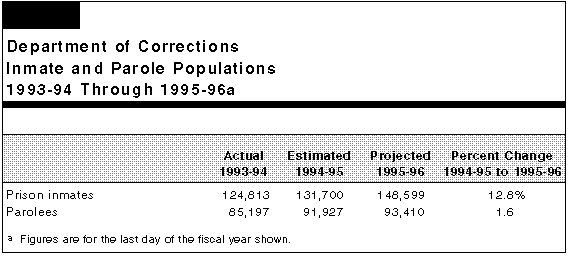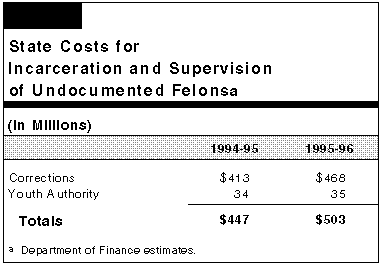The budget assumes that the state will receive $422 million in federal funds to offset the costs of incarcerating and supervising undocumented felons in California. This amount could be substantially overstated.
The Governor's Budget assumes that the state will receive $33 million in the current year and $422 million in the budget year in federal funds to offset the costs of incarcerating and supervising undocumented felons in state prison and the Youth Authority. These funds are counted as offsets to state expenditures and are not shown in the budgets of the CDC and the Youth Authority, or in the Budget Bill. Thus, the Governor's Budget would hold the CDC and Youth Authority budgets harmless should the federal funds not materialize.
Estimating the State's Costs to Incarcerate and Supervise Undocumented Felons. The CDC estimates that about 14 percent of the state's inmate and parole populations consist of undocumented felons. Using these figures, the Department of Finance (DOF) estimates that the costs to the state for these offenders will be $447 million in the current year and $503 million in the budget year (for the budget year, the amount includes $468 million for the CDC and $35 million for the Youth Authority) as shown in Figure 16.

The totals include the costs of: (1) housing undocumented offenders in state prison and the Youth Authority, (2) supervising undocumented offenders on CDC and Youth Authority parole, (3) paying for a portion of the debt service for the construction of new prison facilities to house the share of the state's inmate population that is undocumented. In calculating the costs, the DOF relied on data from the CDC and the Youth Authority and from the Urban Institute in Washington, D.C., which released a report in September 1994 on the fiscal impacts of undocumented immigrants in seven states, including California.
Our review indicates that the DOF's methodology for estimating the costs to the state of incarcerating and supervising undocumented felons is reasonable and is based on methodology that is similar to that used by the Urban Institute and the U.S. General Accounting Office (GAO).
Estimating Federal Funding. The administration estimate of receipt of federal funds is shown in Figure 17 (please see next page). As the figure shows, the administration assumes that California will receive $78 million from federal appropriations made in federal fiscal year (FFY) 1995. Of this amount, $33 million would be available in state fiscal year 1994-95, with the remaining $45 million available in 1995-96. As regards the FFY 1996 federal appropriation, the administration believes that the state will receive $377 million which when combined with $45 million from FFY 1995 will result in a total of $422 million in 1995-96.

Administration's Estimate is Higher Than Current Federal Authorizations and Appropriations. We believe that the administration's assumptions on receipt of federal funds may be high, based on current federal authorizations and appropriations. Although we concur with the administration's estimate that California will likely receive about $78 million over the two years from the current federal budget appropriations, the federal crime bill authorizes an additional $300 million appropriation nationwide for FFY 1996. Thus, we believe that, with the carryover from FFY 1995, California would likely receive a total of about $245 million in 1995-96, instead of the $422 million assumed by the administration.
There are three reasons to be cautious about the administration's estimates of federal funds.
First, at the time this Analysis was prepared, the state had not even received its $33 million share from the federal government for the current year. Administration officials advised that the federal government wants the state to relinquish its claim for full reimbursement before it will provide the amounts appropriated. The administration has advised federal officials that it does not intend to do so.
Second, the Congress has made no appropriations for FFY 1996 and will not do so until later this year. Based on previous experiences, it is not uncommon for the Congress to appropriate much less money for state programs than is authorized.
Finally, legislation has been introduced in Congress to amend the federal crime bill with provisions contained in the Contract With America. Depending on actions on this measure, the Congress could increase or decrease the federal authorization for FFY 1996. (We discuss the proposed federal legislation in our analysis of the federal crime bill earlier in the Crosscutting Issues section of this chapter).
We recommend that the CDC report to the Legislature, prior to budget hearings, on the findings of its audit of the caseload of parolees who are subject to deportation.
Undocumented Felon Population Growing. The CDC has estimated that about 4 percent of the inmates incarcerated in the state prison system are undocumented immigrants who are in the United States illegally. The number of inmates classified as undocumented has grown significantly in recent years, although only slightly faster than the prison population as a whole. Thus, the percentage of undocumented inmates has remained fairly stable.
In contrast, the number of paroled undocumented felons being handed over to federal authorities for deportation is rising rapidly. The portion of the parole caseload classified by CDC as USINS--the step taken to coordinate their deportation by the United States Immigration and Naturalization Service--is estimated to grow 5 percent over approximately a four-year period, as seen in Figure 18.
 As of July 1992, according to CDC data,
4,382 felon parolees had been classified as USINS for deportation. That amounted
to just under 5 percent of the parolee population. The CDC projects that by the
end of the current fiscal year, 9,596 parolees, or 9.7 percent of the total caseload,
will be in the USINS category. By June 1996, the number is projected to reach
10,285, or 10 percent of the total.
As of July 1992, according to CDC data,
4,382 felon parolees had been classified as USINS for deportation. That amounted
to just under 5 percent of the parolee population. The CDC projects that by the
end of the current fiscal year, 9,596 parolees, or 9.7 percent of the total caseload,
will be in the USINS category. By June 1996, the number is projected to reach
10,285, or 10 percent of the total.
Why the Numbers Are Growing. According to the CDC, two factors may be causing a surge in the number of parolees classified as USINS. First, more intense efforts by the CDC and federal authorities to identify prison inmates who are illegally in the United States may account for part of the rise; the immigration status of these inmates may have been overlooked in the past. In addition, the higher number of USINS parolees may also reflect a real increase in the number of undocumented immigrants in the state's criminal justice system.
Many Undocumented Felons Never Deported. Although the CDC has been directed to ensure that as many undocumented felon inmates as possible are deported upon the completion of their prison terms, many are not deported because of inaction by the INS or other procedural complications in the deportation process. In 1992, the CDC calculated that 63 percent of persons who had an USINS classification at the time of their release from prison avoided deportation.
Whether they are actually deported or not, felon parolees judged by the CDC to be deportable are counted somewhere in the parole caseload. Parole cases of those classified USINS and deported are banked on a caseload in order to ensure that some resources are available if the parolee returns to California. They are assigned a very minimal level of bookkeeping and supervision (500 parolees per parole agent). Those who are not taken into custody upon their parole for deportation by the INS are assigned to regular parole units based upon their county of commitment, and are counted on regular CDC caseloads where they are to receive the same level of supervision as parolees who are U.S. citizens (roughly 53 parolees per agent).
Deportees May Be Returning With No Supervision. It is unclear what proportion of the USINS felon parolees who have been handed over to federal authorities for deportation have since returned to the United States or California illegally. According to a previous CDC report, about 19 percent of the parolees released to the INS in 1992 are known to have returned to the United States because of rearrest or contact with parole authorities.
The CDC is currently auditing its entire USINS caseload to assess the status of the felon parolees in this category. For example, auditors are cross-checking arrest records and motor vehicle records to see if deported USINS parolees have returned to California. According to the CDC, preliminary indications are that 20 percent more deported parolees have returned to the state than was previously assumed. If true, this poses a potential threat to public safety, since a sizable number of parolees would be present in the community with virtually no supervision.
Contradictory Fiscal Effects Seen. The audit findings could significantly affect the CDC budget, especially if more felon parolees should be counted on the CDC's regular caseload and thus provided a more intense and more expensive level of state supervision. Meanwhile, increasing success in deportation of illegal aliens could result in major savings in parole supervision costs, because it would reduce the population of felon parolees subject to intense supervision.
For these reasons, we recommend that the CDC report to the Legislature, prior to the budget hearings, on the findings of its audit of the USINS caseload.